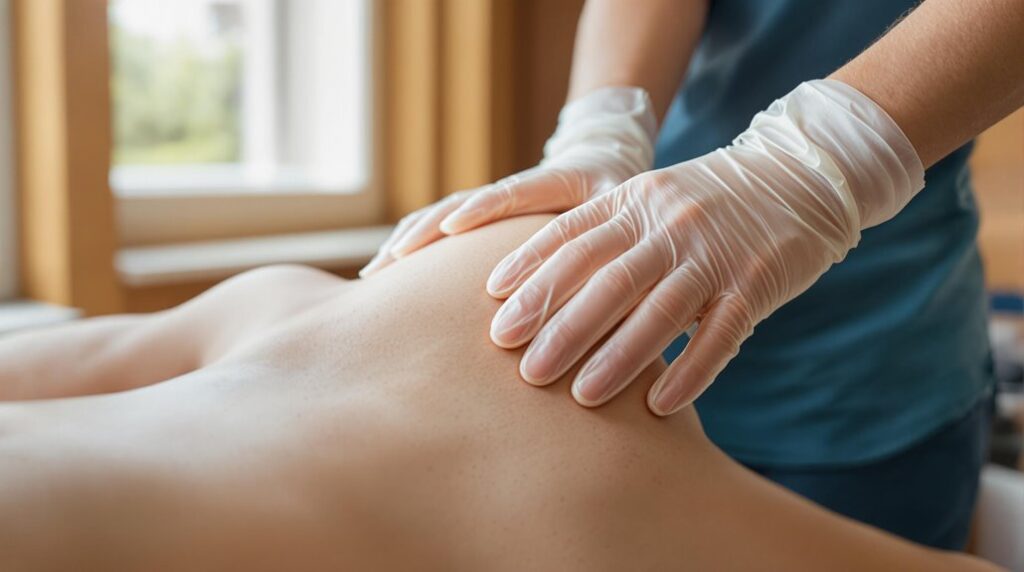You can enhance joint mobility through advanced tissue therapy techniques that combine soft tissue manipulation with targeted exercises. Start with myofascial release using foam rollers or massage balls, applying sustained pressure to tight areas for 10-15 minutes daily. Integrate dynamic stretches and joint mobilizations while maintaining proper hydration and adequate rest between sessions. Following a thorough approach to tissue therapy will release your full range of motion potential.
Understanding Joint Mechanics and Movement Patterns
Before diving into specific joint mobility techniques, it's essential to grasp the fundamental principles of how joints function within the human body. Your joints operate through a complex interplay of bones, ligaments, tendons, and muscles, working together to create controlled movement patterns that enable daily activities.
You'll find that each joint has a specific range of motion determined by its anatomical structure and the surrounding tissues. When you move, your synovial joints rely on smooth articular cartilage and lubricating synovial fluid to reduce friction between bone surfaces. Understanding these movement patterns will help you identify restrictions in your joint mobility, as each joint type – whether it's a ball-and-socket joint like your hip or a hinge joint like your elbow – follows distinct biomechanical principles during motion. Additionally, recognizing the role of preventative measures in maintaining joint health can significantly enhance your overall mobility and reduce the risk of injury.
Advanced Soft Tissue Release Methods
Advanced soft tissue release methods build upon your understanding of joint mechanics by targeting the muscular and connective tissues that influence joint mobility. You'll need to implement specific techniques, such as myofascial release and trigger point therapy, to address restrictions in the surrounding soft tissues. These methods work by applying sustained pressure to tight fascia and muscle knots, promoting tissue elasticity and improved range of motion.
When you're working with fascial adhesions, you'll want to focus on the tissue's three-dimensional nature, applying pressure in multiple directions to effectively break down restrictions. You can enhance these techniques by incorporating active movement patterns, which help reorganize tissue fibers and strengthen the neuromuscular connections that support ideal joint function. Additionally, these advanced techniques align with the principles of preventing future injuries, further enhancing the overall effectiveness of your therapeutic approach.
Self-Myofascial Release Techniques for Joint Health
While professional therapists provide valuable hands-on treatment, you can maintain and improve your joint mobility through self-myofascial release techniques at home. Using tools like foam rollers, massage balls, and specialized mobility devices, you'll target connective tissues that affect joint function and range of motion. Focus on rolling slowly across muscle groups surrounding your joints, pausing on tender spots for 30-45 seconds to release tension.
For best results, you'll want to incorporate both broad strokes and pin-point pressure techniques. Start by working the larger muscle groups that connect to your target joint, then progress to more specific areas. You can perform these techniques daily, but don't exceed 10-15 minutes per session to avoid overstimulating the tissues. Additionally, understanding soft tissue therapy can enhance your approach to self-myofascial release by promoting more effective tissue relaxation and recovery.
Integrating Mobility Exercises With Tissue Therapy
Self-myofascial release techniques become more effective when paired with targeted mobility exercises. You'll want to combine foam rolling and massage with dynamic stretches and joint mobilizations to maximize your results. After releasing tight tissues, you can immediately capitalize on the increased range of motion by performing specific mobility drills.
Start by addressing one area at a time, such as rolling your quadriceps for 1-2 minutes, then performing leg swings or walking lunges. You'll find that this integrated approach helps maintain the tissue's newfound pliability while reinforcing proper movement patterns. For best results, you should perform these combined techniques before your workout, focusing on areas that feel particularly restricted. This method guarantees that you're not just temporarily releasing tension but also retraining your body's natural movement capabilities. Additionally, incorporating sports massage into your routine can further enhance your performance and recovery.
Recovery Strategies and Maintenance Protocols
Once you've established a consistent joint mobility practice, you'll need to implement specific recovery protocols to maintain your progress. You'll find that incorporating proper recovery strategies will enhance your results and prevent potential setbacks in your mobility journey.
- Schedule 24-48 hours between intense mobility sessions to allow proper tissue adaptation.
- Apply cold therapy for 10-15 minutes after high-intensity mobility work to reduce inflammation.
- Maintain adequate hydration with 2-3 liters of water daily to support tissue pliability.
- Get 7-9 hours of quality sleep to optimize tissue repair and recovery.
In addition to these strategies, consider incorporating ankle stability exercises to further enhance your joint mobility and prevent injuries. Your maintenance routine should include regular self-assessment periods to monitor progress and adjust protocols as needed. Don't forget to track your mobility improvements through weekly measurements and movement assessments, which will help you identify areas that require additional attention.

